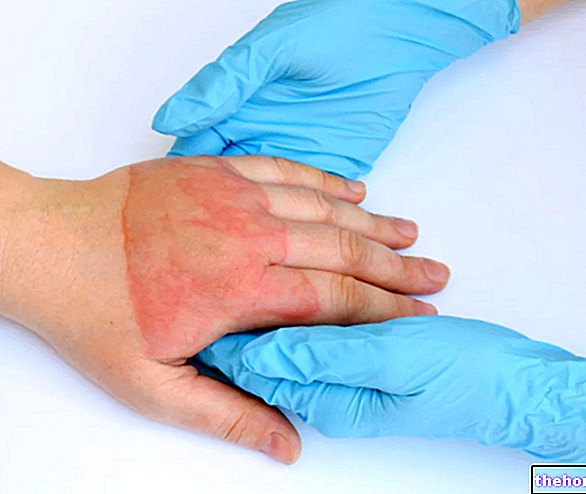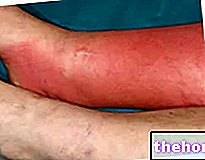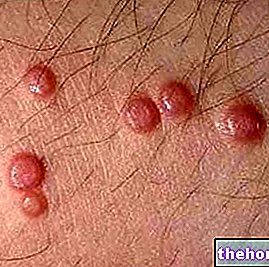What is erythrasma?
Erythrasma is a chronic dermatological infection that mainly affects intertriginous regions of the body (skin folds), manifesting itself as a strong macular rash (similar to a mycosis).
The microorganism involved in the appearance of this condition is the Corynebacterium minutissimum, a bacterium belonging to the indigenous bacterial flora, but which can potentially become pathogenic, under favorable conditions for its proliferation.

Erythrasma is usually a benign condition. However, it can be invasive in subjects predisposed to infection and immunocompromised (in these individuals the susceptibility is secondary to the presence of other related infections, such as endocarditis, pyelonephritis, meningitis ...).
Due to the association of erythrasma with other dermatological diseases, such as punctate keratolysis or axillary trichomycosis, all folds and extremities of the body (hands and feet) must be analyzed during the diagnosis.
From an epidemiological point of view, the worldwide incidence is around 4%. This infection affects both sexes and has a worldwide distribution, although it is more widespread in subtropical and tropical areas.
Pathophysiology
Under favorable conditions, such as heat and humidity, the Corynebacterium minutissimum it proliferates in humid areas, especially in the folds of the skin: it invades a portion of the stratum corneum which, following the infection, appears as thickened. These microorganisms can be identified in the intercellular spaces, as well as inside the cells. The skin spots examined under Wood's lamp take on a coral red color, as a consequence of the characteristic production of porphyrin by the Corynebacterium minutissimum: the presence of this metabolite provides diagnostic evidence of the presence of the pathogen infection.
Signs and Symptoms
For further information: Erythrasma Symptoms
Erythrasma presents with dark, reddish-brown spots, well defined and associated with the appearance of fine scales on the skin which give it a scaly (wrinkled) appearance.
The appearance of these spots is usually limited to the folds of the body that are naturally moist and occluded (groin, armpits, skin folds, etc.). In rare cases, erythrasma can also spread to the trunk and limbs.
Infection is often asymptomatic, but may be associated with mild itching. Symptoms that commonly appear are:
- Lichenification: pathological thickening of the skin that manifests itself with plaques, peeling, with accentuated skin pattern.
- Hyperpigmentation: local discolouration of the skin. Erythrasma is associated with the appearance of usually small red-brown spots.
Furthermore, the strong macular rash can be associated with other fungal infections: for this reason the doctor performs a "differential diagnostic analysis, which allows to discriminate the erythrasma among similar pathologies, which are progressively excluded based on the presence or absence of other symptoms. and clinical signs. For example: the KOH test, usually performed for the diagnosis of Candida albicans, is negative.
Causes
The causative agent of erythrasma is the Corynebacterium minutissimum, a normal member of the skin flora. The main characteristics of the bacterium are:
- Gram positive, non-spore-forming diphtheroid, aerobic, catalase positive;
- ferments: glucose, dextrose, sucrose, maltose and mannitol.
The predisposing factors for infection are the following:
- excessive sweating (hyperhidrosis);
- sensitivity of the skin barrier;
- obesity;
- Diabetes mellitus;
- hot weather;
- poor hygiene;
- old age;
- immunocompromised states.
Differential diagnosis
The differential diagnosis tends to exclude the various similar manifestations in a given subject, through the exact understanding of the set of symptoms and signs found during clinical examinations.
The symptoms perceived by the patient suffering from erythrasma can be confused with pathologies that present similar dermatological manifestations, such as some mycoses; however, the origin of these conditions is clearly different:
- Acanthosis nigricans: skin manifestation characterized by hyperpigmented areas, not delimited, which typically appear at the level of the skin folds.The skin appears thickened, with a velvety surface and a dark brown color.
- Candidiasis: superficial infection of the skin and mucous membranes caused by such a fungus Candida. It is mainly located between the folds of the skin and is favored by maceration. The manifestation includes redness, blistering and exudation of the affected skin.
- Allergic contact dermatitis: immune reaction of the skin to an allergen (for example: nickel, chromium, cobalt, dyes) that induces an inflammation process (also called topical eczema). It manifests itself with redness, peeling, blisters, abrasions and scabs.
- Irritant allergic contact dermatitis: like the previous one, it is a "skin inflammation caused by" the intervention of irritating agents, accompanied by lesions and characteristic signs of the allergic reaction, as well as a burning sensation or pain and sometimes itching.
- Intertrigo: dermatosis produced by the mutual rubbing of two contiguous skin surfaces, also called intertrigo, characterized by redness and exudation (erythrasma does not show any margin).
- Psoriasis: Chronic inflammatory skin disease that can also occur with scaly patches of thickened skin (especially plaque psoriasis can be confused with erythrasma, as both lesions are scaly).
- Seborrheic dermatitis: affects areas rich in sebaceous glands of the skin (especially scalp, face, chest and ear canal); its appearance is characterized by yellowish and greasy scales, and is associated with erythema and folliculitis.
- Tinea corporis: superficial mycosis that affects the skin in areas of the body devoid of hair, manifesting itself with itching and circular, pinkish, desquamative lesions, with sharp edges in relief and a lighter center.
- Tinea cruris: fungal infection affecting the groin and thighs. Mycosis presents as a small erythema (round spots, clearer center, well-defined, scaling margins) and annoying itching (erythrasma is not associated with itchy sensation).
- Tinea pedis: mycosis mainly caused by the Trichophyton, initially located between the toes of the sole of the foot. This infection is manifested by itching, burning, redness, peeling, abrasion and skin rashes.
Diagnosis
The diagnosis of Erythrasma is made outpatient with the help of the Wood's lamp. The disease cannot be diagnosed with a blood test or blood culture, but there are specific microbiological cultures that allow to isolate the Corynebacterium minutissimum (first, however, the doctor must obtain clinical clues about the potential responsible organism, in order to set up the correct analysis).
- Examination with Wood's lamp: the analysis of the lesions of the erythrasma reveals a coral red color to the fluorescence. The cause of this color has been attributed to the synthesis of excess coproporphyrin III by these microorganisms. Coproporphyrin accumulates in the skin tissues and, when exposed to a Wood lamp, emits a typical coral red fluorescence that allows to highlight any foci of infection. The results can be falsely negative when the patient cleanses the skin before undergoing the test (The pigment can be washed off.) If suspected, it may be necessary to repeat the test the next day.


Axillary erythrasma and appearance of skin affected by Wood's lamp erythrasma
Image source: http://www.dermnetnz.org/bacterial/erythrasma.html
In short: coproporphyrin III in human physiology
Coproporphyrin is a pigment with a tetrapirrolic structure belonging to the group of porphyrins. Coproporphyrin are contained in various human organs and are usually eliminated in small quantities by the urinary and intestinal routes. Coproporphyrin III is an intermediate product of hemoglobin biosynthesis.
- Microbiological culture: to highlight an "alteration in the bacterial flora, it is possible to collect a sample to be subjected to microbiological examination, by scraping the lesion. Gram stain highlights long filaments that reveal the presence of the Corynebacterium minutissimum: the microorganisms do not produce haemolysis (the enzymes therefore do not induce the breakdown of red blood cells) and grow in culture in smooth colonies of 1.5 mm.
- Histological examination: the bacteria that cause erythrasma are present in the stratum corneum and are detectable by the typical filamentous formations in which they are structured. The histological examination of the lesions helps to provide diagnostic evidence.
Treatment
The goal of drug therapy is to limit bacterial proliferation, eradicate infection and prevent complications. Gently cleansing the spots on the skin surface with bactericidal or antifungal soaps can help limit bacterial proliferation. Topical administration of erythromycin is very effective (macrolide antibiotic that inhibits protein synthesis). In severe cases, the doctor may prescribe systemic therapy.
To eradicate Corynebacterium minutissimum it is possible to use antibacterial and / or antifungal agents, which allow to control also concomitant infections. The drug of choice is erythromycin; the infection can be treated with either topical or systemic administration (taken by mouth).
In general, the recommended initial therapy is based on the administration of fusidic acid (a bacteriostatic antibiotic, which limits bacterial replication without killing the microorganism) or, alternatively, the application of a topical tetracycline (an antibiotic that acts by inhibiting protein synthesis). in case of treatment failure, a drug with a systemic effect should be chosen, such as amoxicillin-clavulanic acid (amoxicillin belongs to the penicillin group and works in synergy with clavulanic acid, which increases the efficiency of the antibiotic blocking the activity of bacterial enzymes beta-lactamase).
Corynebacterium minutissimum and sensitivity to antibiotics:
Erythrasma is usually treated with fusidic acid (topically), systemic macrolides (such as erythromycin and clarithromycin) and / or azole derivatives (antifungal agents, eg: imidazole).
The Corynebacterium minutissimum it is generally sensitive to penicillins, first generation cephalosporins, erythromycin, clindamycin, ciprofloxacin, tetracycline and vancomycin.
We can highlight the following degree of sensitivity for the drugs listed above:
- Corynebacterium minutissimum is positively affected by treatment with erythromycin or erythromycin
- the bacterium is not very sensitive to penicillins and poorly to ciprofloxacin
In addition, the bacterium can develop resistance to various therapeutic agents (multi-resistant strains have been isolated and often culture isolation and antibiogram are not performed).
In summary: the therapeutic options for erythrasma
Topical agents
bactericidal or antifungal soaps, erythromycin (gel), fusidic acid (ointment)
Antibiotics
erythromycin, clarithromycin
Topical antifungal agents with activity for erythrasma
miconazole, clotrimazole, econazole
An alternative treatment can be provided by red light photodynamic therapy (broadband, peak at 635m), which can eradicate erythrasma in some cases.
In conditions of coinfection, therapy must be systemic and aimed at the pathogens involved in the clinical context.
Complications
Following the onset of erythrasma, the following complications are possible:
- fatal septicemia in immunocompromised patients;
- infective endocarditis in patients with valvular disease;
- infection with Corynebacterium minutissimum in post-surgical wounds.
Prognosis
The prognosis for erythrasma is excellent and predicts full recovery following treatment. However, the condition tends to recur if predisposing factors are not eliminated.
Prevention
The following measures can reduce the risk factors that predispose to erythrasma infection:
- take care of hygiene on a daily basis;
- keep the skin dry;
- wear clean, non-occluding clothing;
- avoid excessive heat or humidity;
- maintaining a healthy body weight.




























